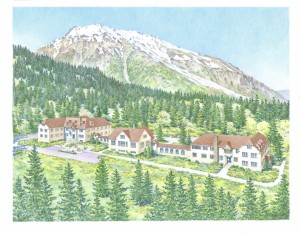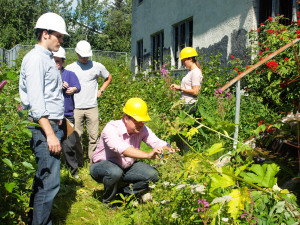
The Jesse Lee Home in Seward Alaska – a rendering of its original form. Image courtesy Friends of the Jesse Lee Home.
The Jesse Lee Home in Seward, Alaska was a boarding school that housed children who were displaced by the epidemics that swept across Alaska in the early 20th century. The Home closed after the 1964 Good Friday Earthquake and has remained vacant since then. The Friends of the Jesse Lee Home is renovating this historic structure with a sustainability purpose that is true to its original mission.
The Jesse Lee Home for Children opened in 1926. Many Alaska Native children orphaned by epidemics, particularly devastating in western Alaska where medical care was extremely limited, lived at the home. It was one of the largest and most stable institutions to care for and educate the hundreds of orphaned children. A number of Alaska’s outstanding Native leaders were raised and educated at the Jesse Lee Home during its Seward years. John Ben “Benny” Benson, Jr., from Chignik, was one of the children who lived at the Home. In 1927, his design was selected for Alaska’s territorial, and later state, flag.
The Jesse Lee Home was built between 1926 and 1937 and its historic period of significance has been identified as 1926-1942. The complex was comprised of the Jewel Guard Hall, Balto Hall, Goode Hall, Mission Territorial School and various outbuildings. Following the devastating 1964 earthquake, the Methodist Women’s Home Missionary Society, who ran the home, decided to close it. Goode Hall was severely damaged by the earthquake, and the other buildings needed major repairs.
Today only Jewel Guard Hall, Balto Hall, the foundations of Goode Hall and their related arcades remain. Designed by architect, Stanley Shaw, the buildings are representative of the less ornate versions of the Tudor Revival Style popular in the 1920s and 1930s. The style is warmly vernacular; presenting a mix of late medieval English inspired building elements. The site was listed in the State and National Registers of Historic Places in 1995.
Rehabilitation
The Friends of the Jesse Lee Home is a nonprofit organization committed to launching and sustaining an Alaskan leadership school at the historic Jesse Lee Home. They are working to preserve Alaska’s past and ensure its future by refurbishing the historic Jesse Lee Home into the home of a statewide public residential leadership charter school, called the Balto School.
The goal of the rehabilitation project is to retain as much of the original exterior as possible, while adapting the remaining buildings for a new leadership school. Much of the original stucco remains and is in excellent shape. The roof and its materials are in very poor condition and virtually none of the original windows, door or trim remain. Since the buildings have been vacant for over 40 years, nearly all interior finish materials, stud partitions, doors, trim and mechanical/electrical components are missing. The major objective for the rehabilitation of the Jesse Lee Home is to sustain the existing form, integrity and materials of this historic property.

The Sustainability Team met with agencies in Seward to review current renewable energy approaches in the region.
Funded by a grant from the State of Alaska, the Friends of the Jesse Lee Home are working with Kumin Associates Architects and their consultants to design the rehabilitation. Barbara A. Campagna/Architecture + Planning, PLLC and Apollo BBC, experts in integrating sustainability practices with historic preservation, are supporting the team and client as the sustainability consultants. The project is targeting LEED Platinum (for Schools) and is focusing its innovative sustainability approach on developing a comprehensive energy use plan that integrates renewable energy sources such as wind, solar and geothermal in order to use locally available resources and remove the Home from the grid. Sixty-five % construction documents have been completed.
This past July, the sustainability team conducted an eco-charrette with the client team and toured local renewable energy projects (wind turbine, solar arrays and geothermal projects) in Seward, also meeting with the City to discuss the potential of creating an eco-district. Stay posted for updates as the project proceeds in 2015.
And if you’d like to “subscribe” or follow my blog, True Green Cities, please sign up through the “Subscribe” button at the bottom left of this page. You’ll receive a daily recap when new blogs are posted. Or Sign up for the Feed.



